Travel 2.7 million light-years from home to the Pinwheel Galaxy, where we'll visit a supergiant star, an extragalactic globular cluster, and one of the largest nebulae in the known universe.
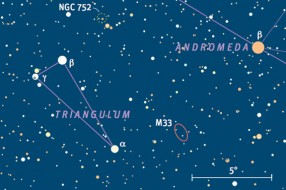
S&T: Lauren Darby
A star. A nebula. A globular cluster. Three different kinds of objects we might observe on a crisp fall night within the Milky Way galaxy. What if I told you you could see them in an entirely different galaxy 2.7 million light-years away?
Tonight we're going to explore all three in the Triangulum Galaxy, also known as M33 or the Pinwheel Galaxy. I remember when just finding M33 was a feat requiring the darkest of nights and a good telescope.
Expectations have changed over the years, not only because of larger, more affordable instruments and better maps, but also because amateurs are pushing beyond the traditional limits of what can and can't be seen in a particular-sized telescope. Attitude can often be as effective as aperture when it comes to observing the deep sky.
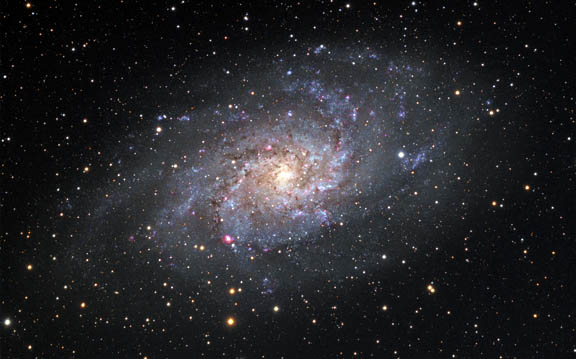
Hunter Wilson Astrophotography
Focusing on the Triangulum Galaxy allows us to see how far we've come. Some 30 deep-sky objects are visible in medium-to-large amateur telescopes in M33, most of them appearing as diffuse patches of light representing a rich assortment of stellar associations and emission nebulae. For a full list and guide, I refer you to Alan Whitman's excellent write-up that appeared in the December 2004 issue of Sky & Telescope.
Let's cherry-pick three: NGC 604, one of the largest and brightest emission nebulae known; C39, the brightest globular cluster in M33; and B324, the brightest individual star in the galaxy.
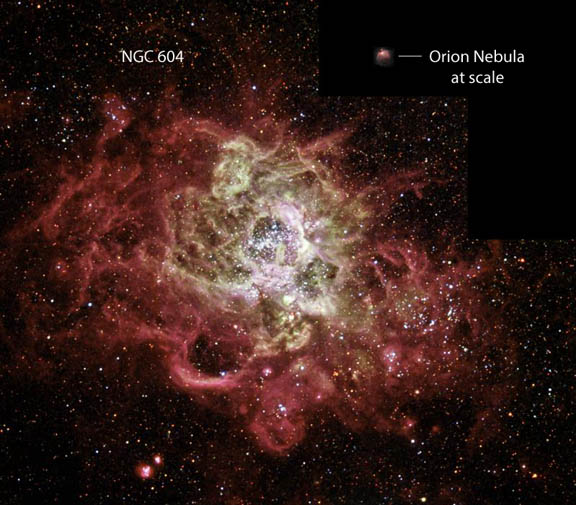
NASA / Hubble Heritage Team (AURA / STScI) / Wikipedia
Glowing at 12th magnitude and fully 2′ across, NGC 604 is probably the easiest-to-see extragalactic nebula in the entire sky outside of the Tarantula Nebula in the Large Magellanic Cloud. You'll often read that the Tarantula is larger, but its diameter of ~650 light-years spans less than half that of NGC 604, the tendrils of which loop out across nearly 1,500 light-years.
Many of us have viewed the Orion Nebula, which can easily fill an entire low-power field of view with curdles and tufts of nebulosity. Well, move over Orion! NGC 604 is more than 50 times as large and 6,300 times brighter; if it were at the same distance as the Orion Nebula (1,350 light-years) we'd cower in its presence as the gargantuan nebula would cover some 50° of sky.
Both are lively stellar nurseries busy cranking out new stars. Their powerful UV light ionizes the surrounding gas into colorful swirls of pink and green. NGC 604 is a young pup, making its debut about 3.5 million years ago around the same time "Lucy", one of our early human ancestors, walked upright.
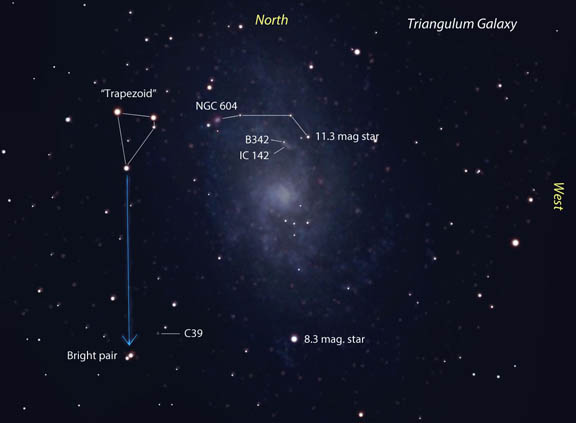
Stellarium
Now, 3½ million years later, I stand upright at the telescope and see a small, dense cotton wad of luminous fuzz 1′ northwest of a Milky Way foreground star using my lowest magnification on a 15-inch (37-cm) telescope. Even a 6-inch scope will show this massive star-forming complex. The fun begins when you increase the magnification to 200× or higher and really dig into the nebula. With averted vision, it extends east-west and shows a double-stellar brightening (two side-by-side condensations) in its eastern half with a much "smaller" or fainter condensation slightly west of center.
Comparing what I see to deep photographs, it's clear that the separate kernels are brighter chunks of nebulosity near the object's core. Despite its relatively small size, there's a palpable sense of something vast here. Mediocre seeing wouldn't allow anything higher than 245×, but I can't wait to see what 400× might reveal on a more serene evening.
A brief stroll from NGC 604 we next encounter one of the most amazing sights in the sky — a star visible across a gulf of 2.7 million light-years. Perhaps like me, you've seen a number of supernovae in galaxies far more remote, but they're supernovae after all. To see one, the star has to self-destruct. They don't exactly count.
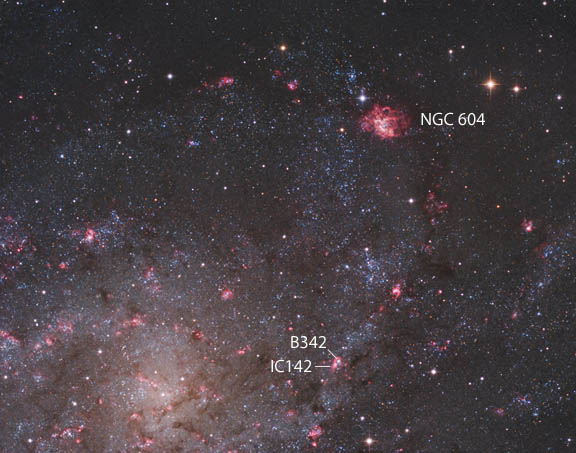
Volker Wendel / Josef Pöpsel / Stefan Binnewies (Capella Observatory)
B324, the brightest star in M33, is an A-type supergiant that lies along the northwestern edge of the stellar association IC 142 just 6' from the center of the galaxy. The starry gathering appears as a shred of faint fuzz, but to my complete surprise, B324 stood out like a tiny beacon of light. Its given magnitude is 15.2, but it appeared slightly brighter to my eye, closer to 14.8 or 15.0. That places it within the reach of a 10-inch telescope. 245× brought it nicely into view.
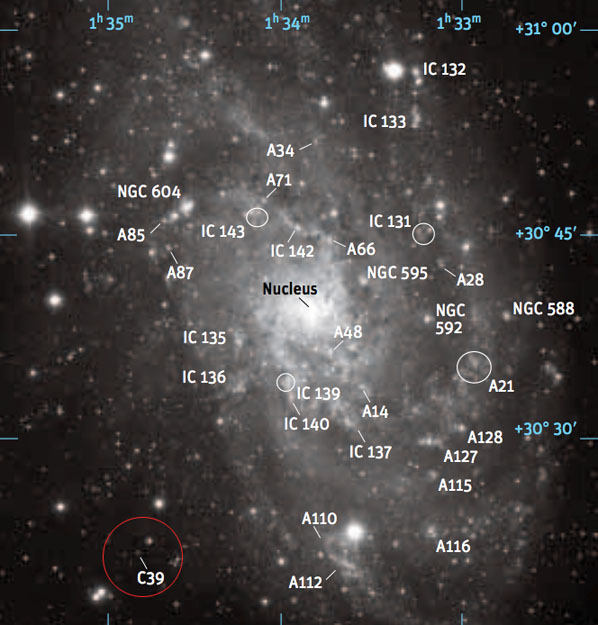
Robert Gendler
Our final object, C39, listed as the brightest globular cluster in the galaxy, looks anything but. Because it's at magnitude 15.9, you may find yourself working your averted vision chops hard to see it. After persisting for several minutes, I finally glimpsed a slightly fuzzy "star" that came and went intermittently. Fortunately, the globular's easy to find, located 3′ northwest of a bright pair of 10th-magnitude stars along M33's southeastern side.
When seeing smallish, faint objects, never hesitate to climb to the next level of magnification. As long as seeing conditions allow for sharp, steady images, high power will darken the sky more and improve contrast and visibility.
I could find little information on C39 except that it was intermediate in age. For additional details and eyepiece impressions, please visit Rich Jakiel's Globular Clusters in M33. Leonardo Orazi's M33 Triangulum Galaxy astrophotography page features superb color imagery of our trio plus many other deep sky targets in M33.
I've only touched on what this galaxy has to offer. Should you decide to tackle its numerous stellar associations and nebulae, you'll never want for observing challenges this month. After you've spent an evening among its clusters and nebulae, you'll walk away feeling like you just traveled millions of light years from home. Nothing could be closer to the truth.
The year's almost over! Don't forget to buy your Sky & Telescope 2016 Observing Calendar!
 0
0
Comments
You must be logged in to post a comment.